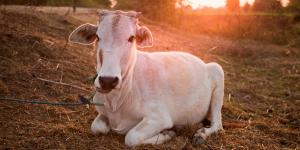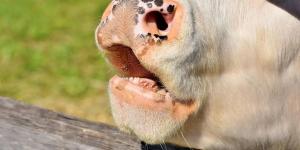Can Cows Swim?

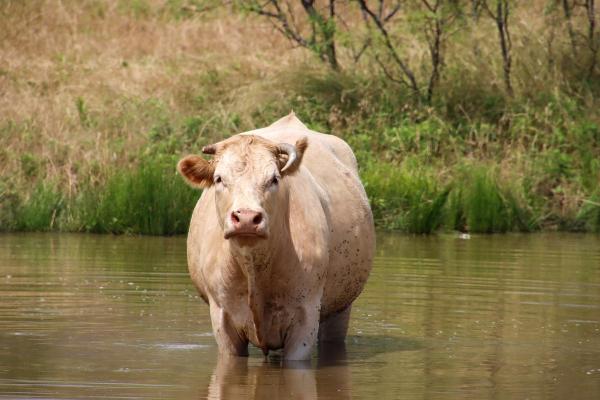
Cows, also known as cattle, are large domesticated mammals that have played a significant role in human societies for centuries. They belong to the Bovidae family and are primarily raised for meat, milk, and other useful byproducts. But have you ever wondered if cows can swim? Despite their robust build and seemingly land-adapted anatomy, these remarkable animals possess the ability to swim, much like other mammals.
In this AnimalWised article, we will delve into the topic of cows and swimming. We will explore their aquatic abilities and shed light on how these fascinating animals navigate through the water.
Can cows swim or not?
Despite not being naturally aquatic animals, cows can indeed swim. While cows' anatomy is primarily adapted for terrestrial life rather than swimming, they do possess certain features that enable them to move in water and swim to some extent.
Cows' large and sturdy bodies provide them with a degree of natural buoyancy. With their bodies primarily composed of muscle tissue and fat, they are less dense than water, allowing them to float and stay afloat.
The limbs of cows also play a significant role in their swimming ability. Although their short and stout legs are not the most streamlined for water propulsion, cows can move them in a manner similar to walking or running. This movement allows them to generate momentum and propel themselves through the water, although their speed and efficiency compared to specialized swimmers are limited.
Why do cows swim?
Cows occasionally engage in swimming for various reasons. They may swim to access more favorable grazing areas or seek refuge in water to evade predators. Additionally, cows might take to the water to cool down during hot summer days.
It is not uncommon to witness cows swimming, including with their calves, and such behavior can be observed especially during periods of flooding.
Be sure to read this other article, where we discuss what do cows eat besides grass.
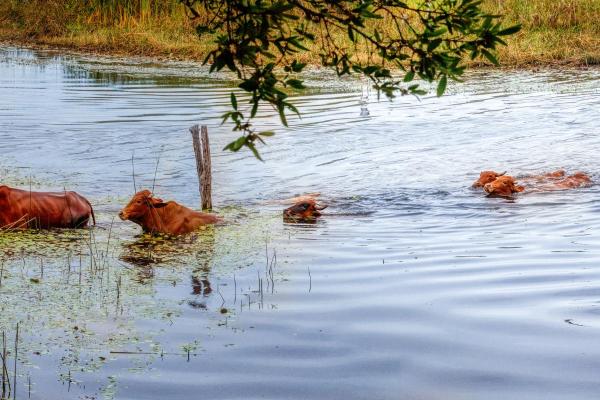
How do cows swim?
The swimming style of cows differs significantly from that of specialized aquatic animals. While they may not be graceful or fast swimmers, cows employ a combination of movements to navigate through the water.
When a cow finds itself in water, it typically keeps its head and neck elevated above the water surface, allowing for breathing and maintaining orientation while swimming. Their limbs come into play for movement, although the coordination may be less refined compared to species adapted for swimming.
Cows often move their legs in a similar fashion to when they walk or trot on land. This involves a back-and-forth motion of the legs to generate forward momentum in the water. However, due to their size and lack of specific adaptations for swimming, leg movement in water can be heavier and less efficient.
In addition to their limbs, cows may employ their tail to assist in movement. The tail acts as a rudimentary rudder, enabling them to make adjustments and maintain some degree of directional stability while swimming.
It's important to understand that cows are not agile or fast swimmers. Moreover, cows may experience reduced physical stamina during prolonged swimming, making it crucial to avoid situations where they are forced to swim long distances or encounter strong currents without adequate supervision or assistance.
If you've ever wondered why cows are considered sacred in India, don't miss our article, where we delve into the significance and cultural reasons behind it.
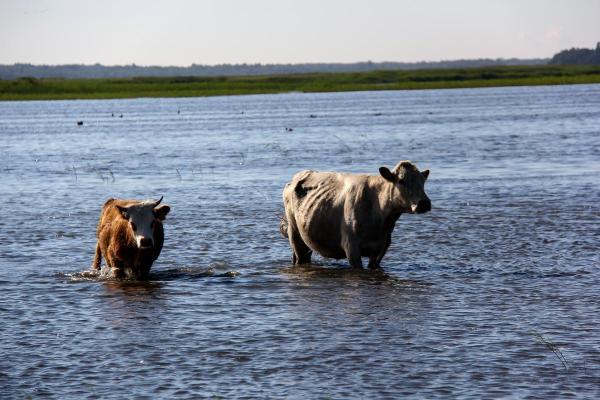
Do cows like to swim?
Cows do not have a natural inclination or inherent preference for swimming. Being terrestrial animals, their primary habitat is land, and they do not actively seek out bodies of water for the purpose of swimming. Swimming is not a typical behavior or activity for cows in their natural state.
However, when cows encounter situations where they need to cross a river, stream, or pond, they may enter the water and swim as a response to specific circumstances or needs. It's worth noting that individual cows may exhibit varying tendencies when it comes to swimming.
Some cows may display aversion or resistance to water, which could be attributed to factors such as unfamiliarity with the aquatic environment, previous negative experiences, or personal preference. These cows may be reluctant to enter the water or exhibit signs of stress while swimming.
On the other hand, certain cows may adapt more readily to water and demonstrate a greater willingness to swim. This can be influenced by early exposure to water, increased confidence and familiarity with aquatic environments, as well as a more curious or adventurous temperament. Such cows may derive enjoyment from swimming and appear more comfortable in water.
Prolonged or deep-water swimming can be physically demanding for cows and may create stress or safety hazards. Therefore, while some cows may exhibit adaptability or a willingness to swim, it's crucial to exercise caution and provide them with a controlled and secure environment when they are around water.
If you're curious about whether cows have teeth, don't miss our article, where we provide detailed information on the subject.
If you want to read similar articles to Can Cows Swim?, we recommend you visit our Facts about the animal kingdom category.
- Melletti, M., & Burton, J. (Eds.). (2014). Ecology, evolution and behavior of wild cattle: implications for conservation .
- Saylor, B., Elliott, TA, Linquist, S., Kremer, SC, Gregory, TR, & Cottenie, K. (2013). A novel application of ecological analyzes to assess transposable element distributions in the genome of the domestic cow, Bos taurus . Genome, 56(9), 521-533.

